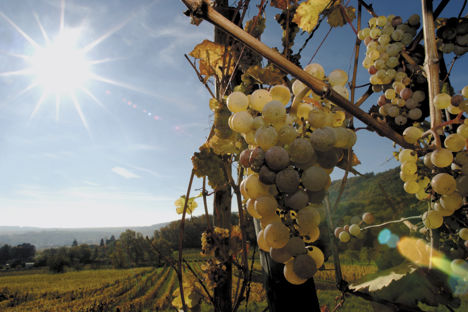
Alsace wine: a beginner's guide
Want to know your Gentil from your Gewurztraminer? Check out our guide to the different wine varieties of Alsace.
Alsace wine: a beginner's guide
Want to know your Gentil from your Gewurztraminer? Check out our guide to the different wine varieties of Alsace.
There are certain parts of the world that are intrinsically linked with winemaking. Bordeaux, Marlborough and Champagne are all regions that instantly make us think of rich reds, fruity whites and crisp sparkling wines. But one lesser-known region that’s home to just as much heritage and quality than these vinous heavyweights is Alsace. With a huge variety of styles, bottles meant to be drunk young, vintages which sit in cellars for years and wines perfect for nearly every occasion, it’s an incredible place for anyone even remotely interested in wine. Read on to learn more about the most common styles of wines made in Alsace, what foods they go with and when to enjoy them.
Crémant d’Alsace
First made over a century ago, Crémant d’Alsace is an AOC-protected sparkling wine using the same traditional methods as Champagne and is the bestselling AOC sparkling wine (excluding Champagne) in France. Over 500 wineries in the region now produce Crémant, which comes in a variety of styles. Most taste fresh and dry with buttery and tropical fruit flavours, and they’re perfect for toasting a celebration, serving with canapés, or to be simply enjoyed on their own.
Gewurztraminer
Gewurz means ‘spicy’ in Alsatian, which perfectly sums up these bold, lively wines. They’re the style of wine most associated with the region and the eponymous grape used to make them grows particularly well in the area. The most common flavours are rose, lychee and ginger, which makes Gewurztraminer a little bit different from the average white wine, and it can stand up to even the most strongly flavoured food. It goes particularly well with Asian cuisine – everything from Indian and Chinese to Thai and Malaysian – which can sometimes be difficult to pair with other styles of wine.
Pinot Blanc and Pinot Gris
While these are both styles of wine found all over the world, in Alsace they develop some unique characteristics. Pinot Blanc grapes are used to make sparkling Crémant, but when used for still wine the style becomes fresh, floral and easy to drink. This makes it perfect for almost any occasion, particularly when you’re entertaining guests and need something that’ll please all palates.
Pinot Gris is slightly more varied, with a golden hue and, depending on how old it is, more unique and complex flavours. As it ages, flavours of tropical fruits become more and more prominent along with musky, richer notes. This is a wine for a special occasion – save it for a memorable dinner party and serve it towards the end of the meal to round it off perfectly. The flavours of wine also make it a perfect match dishes with mushrooms such as risotto, white meats and particularly veal.
Pinot Noir
Pinot Noir is the only red wine produced in Alsace, so if you happen to spot a bottle make sure you snap it up! Although Alsace Pinot Noir wines are full of berry and cherry fruit flavours, an increasing number are fuller bodied, offering something a bit different from the norm. Fruit is always at the heart of the wine and is never overpowered by oak, while the crisp, delicate, fruity notes go particularly well with charcuterie and cold cuts. Serve it alongside a light lunch of antipasti, a larger buffet at a party, salads or smoked meats to really appreciate the style’s character. The fuller bodied wines make a great match to red meats and are perfect for the barbecue season.
Riesling
If you’re after freshness above all else, then you can’t go wrong with Riesling. There are many styles, but most have strong golden fruit flavours and a mineral-like saltiness, which grow stronger with time. Younger varieties are made to be drunk fresh and are full of fruit, whereas more mature vintages become dry and zesty, ready to drink after a few years. Any fresh fish or shellfish is a perfect match – so if you’re pushing the boat out with a platter of oysters, planning a dinner party starter focused on scallops or simply enjoying a quick midweek dish of prawns and spaghetti, you won’t find a better match than Riesling. However, if you’re not too keen on fish, Riseling also goes particularly well with poultry.
Everything else
The types of wine listed above are the most common varieties produced in Alsace. But, if you’re keen to seek out the more unusual or rare styles made by just a few, then there are some bottles that will really prove a talking point at the table. Only two percent of the grapes grown in Alsace are Muscat, but the resulting wine is usually bone dry and makes a very interesting aperitif. Edelzwicker and Gentil are both blended wines which are easy to drink, and Klevener de Heiligenstein is one of the rarest grapes at all – only five villages still use them to make wine, so you’ll be lucky to see a bottle.
As you can see, there’s an Alsace wine to suit every occasion, palate and meal. Next time you’re on the lookout for a bottle of something nice, keep them in mind – you’ll soon see why they’re the wine world’s best kept secret.


